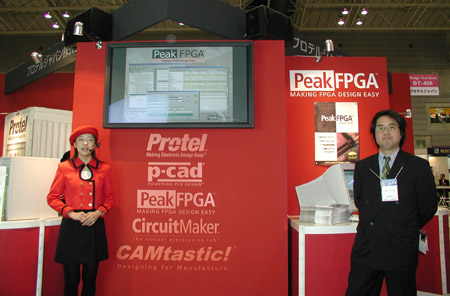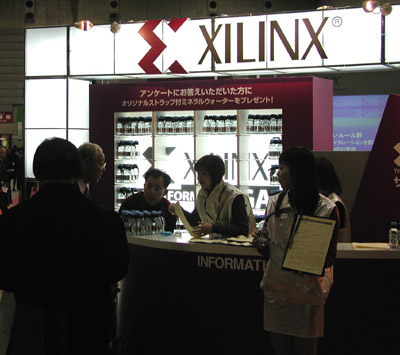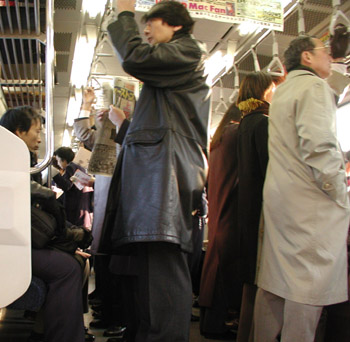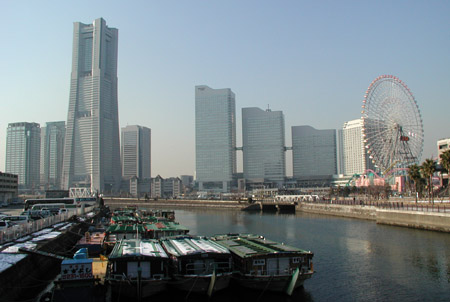
Today dawned with low clouds and rain. I had breakfast downstairs, put on my suit and tie and walked through the mist to the convention center. This trade show was my pretext for coming to Japan, although it's not really clear if there's a benefit to my being here.
Here are two pictures from the show today:

This first picture was taken at the Protel booth, where our local staff had set up an impressive little presentation/demonstration with the hired talent on the left as narrator. I was amazed that she had memorized every word of a deeply technical, jargon-filled (and quite lengthy) description of the product and its features. It was fun to hear things like "The PeakFPGA direct-compile VHDL simulator supports IEEE standards 1076, 1076.3, IEEE 1164 and SDF back-annotation..." spoken in rapid-fire Japanese while she gazed with apparent boredom at the wall across the aisle.

The second picture is part of the much larger Xilinx booth. At this booth the "companions" seemed to outnumber the guests by a factor of two to one. (Trade show "companion girls" are an anachronism that disappeared from the states -- except perhaps at conventions held in Las Vegas -- a decade or more ago. In Japanese shows these young women are dressed in sometimes absurd, often sexually suggestive costumes and do nothing but smile vacantly and sing out "welcome!" while handing out brochures and promotional doo-dads.)
At the Chronology booth I bumped into someone I knew (Mike Merideth) and we talked for while about business. He had spun out of the same company (Data I/O) a few years earlier than I had, and his company was now quite successful with strong growth and venture capital to back it. He mentioned that Chronology had been trying to recruit me and I said yes, I' been in touch with their VP of engineering. But I confided to Mike that I had gotten pretty tired of the whole industry and was trying not to think too hard at the moment.
We talked instead about families, about mutual friends and about glass art. Mike is an occasional glassblower who has probably crossed paths with Devi at the Seattle Glassblowing Studio.
"I started into it by collecting," he said. "But then I'd find these amazing pieces and ask myself, 'how the hell did they do that?' I wanted to know, so I started taking classes and I got hooked... It's like, when you're blowing glass there's nothing else. No mortgage, no family, no work, nothing. Just that hot lump of glass, and nothing else."
I promised to call when I got back to the states.
After getting up in the morning yesterday and having breakfast downstairs I went for a long walk through the districts of central Yokohama, first to Sakuragicho station, again up Isezaki mall, then south and east through Chinatown to the waterfront park. From there I went into the fashionable district (formerly the American and British enclave) of Motomachi.
It was a bit early for shops to be open, but the cafe scene on the street was lively. The coffee shops and bakeries were full of students, housewives, businessmen, and an above-average number of foreigners.
The area around Motomachi (and in particular the hill to the south of the district) has become, in recent decades, a magnet for Japanese "new rich" as well as foreigners with the necessary resources to live there. Though the economy is down there still seems to be enough money to splash around. I passed a number of expensive cars parked on the street, including one rather large Bentley that was probably worth as much as a decent new house in Redmond.
More odd juxtapositions: There are spots you can stand in Motomachi where your view is bewildering. Put your hands up to your face to form a crude telescope, then turn slowly around... An old woman with a white headscarf and straw sandals is sweeping the stones of a shrine with a whiskbroom made of reeds. Two high-heeled ladies with expensive handbags and sunglasses are enjoying their cigarettes and coffee while sitting at a table outside a Starbucks store. A construction worker in split-toed booties and baggie blue pantaloons is measuring the window of a jewelry store (where the katakana characters on the glass advertise "ro-ru-re-ku-su" watches). A perfectly manicured corgi stretches on his leash as he sniffs at the fish displayed outside a market, its owner oblivious as she searches for something in her purse...
After walking through Motomachi I angled back through Chinatown and into Kannai once again, to the office of my friend (and business associate) Katsumi Kurashige. I borrowed a computer to check emails (and post to the journal), we talked shop for a while, then we went to lunch with his two staff members at a Chinese restaurant.
Later in the evening, after spending more time getting work done in the hotel room I met a friend (Mikano) for an enjoyable dinner at an Italian restaurant. The food was good and we sat there chatting until the place closed and we were politely thrown out.
Yesterday I walked around Yokohama for a few hours before going back to the hotel for some work (writing an overdue specification, answering too many emails). The weather was good for walking, crisp and cold but sunny.
This is my tenth (and probably my shortest) trip to Japan. I don't know how many days and nights I've spent in Yokohama in total, or how many times now I've walked the streets between Sakuragicho and Kannai stations looking for lunch or dinner, or just exploring.
I suppose what I like about Yokohama is its lack of blandness. It's not the prettiest place in Japan (not by a long shot) but the contrasts set it apart from anywhere else. Contrasting colors, styles, smells, and sounds.
In Tokyo (to the north) it's easy to get the sense of sameness in the larger districts. The same nondescript office buildings, the same bicycles parked endlessly along the sidewalk, the same jostling taxis and jostling people, the same neon signs, battleship-sized billboards and noisy pachinko parlors.
And even in the historic places (Kamakura, Kyoto, Odowara) you find the same repeating scenes. They may be exquisitely beautiful, but it can be hard to distinquish one temple or shrine (or a grove of cherry trees, or a pond full of rocks and carp, or a statue or monument) from another after you've seen a dozen of them in a day, or a hundred in a week.
In Yokohama there is a haphazard, little-planned arrangement of districts that are all within an easy walk of each other. Every view (be it from a building window, a hilltop or a broad avenue) presents you with odd juxtapositions. Dragon boats tied up for the season and floating quietly in front of the largest (and most architecturally striking) building in Japan; old women in kimono shuffling along through the ultra-modern, marble-floored boutiques of Queen's East mall; men in suits riding bicycles down Isezaki boulevard; girls in Chinatown wearing knee-high boots and short-short skirts, tapping away furiously at their instant-messaging mobile phones; homeless men wearing multi-colored rags; poodles wearing perfectly tailored sweaters... and Lebanese street vendors, Korean and German businessmen, Nigerian bouncers, Philipina bar girls, American english teachers and Australian waitresses, Buddhist monks and Shinto priests, Eddie Bauer, Starbucks, The Gap... All of Japan, and all of its contradictions, seem to be here in one place.
I had dinner at a small sushi place in the shopping mall downstairs from the hotel, stopped at a bookstore to pick up some things for Satomi, then got to bed early.

My flight arrived into Narita today at 6:00AM. We were the first airplane of the day to land, after a twenty minute hold (Narita has a flight curfew due to noise). There were very few people on the plane so I had three seats across (window, center and aisle) and could stretch out and get some sleep on the overnight flight. It's unusual for me to sleep on an airplane so this was a real luxury. And when I wasn't sleeping I had a good book to read (Arabian Sands by Wilfred Thesiger), so all in all it was a good flight.
On arriving at Narita the customs and immigration was fast and easy, and I got down to the train station by 6:45. I had planned to take the Narita Express train to Yokohama, but that train didn't leave until 8:15. So instead I bought a ticket (at about one fourth the price) on a commuter train, the Rapid Express.
The Rapid Express was nearly empty from Narita to its first stop (Chiba, I think). I took a seat right next to the door and put the rolling suitcase on the rack above, with my laptop between my feet on the floor.

The ride into Tokyo took about 90 minutes, and at each stop the train became progressively more full. This was the height of the morning rush hour, and by the time we were in the central area of Tokyo people were packed in solid. ("Clickity, clack," went the wheels on the track; "sniff, sniff," went all the runny noses... it's winter here for sure.)
Seated as I was (facing inwards) I was surrounded by a wall of thick overcoats, briefcases and handbags. I became intimately familiar with the stitching on a variety of brown and black Louis Vuiton and Prada bags (I was not impressed), and at one point I felt something soft and heavy (a person or a parcel I know not which) being set down on my knee, a part of my body that had long since disappeared among the soft masses of Pierre Cardins and Max Maras.
At each inner city station a sea of people would flow out the doors and then back in. People would exit, more people would get on. The more savvy riders would catch the ebb tide going out, then immediately ride the flood back in to ensure that they remained near to the door (or perhaps just to catch a quick breath of fresh air). At each change of the tide the current would increase and back-eddies would form around my legs and my laptop case. I watched as one woman got caught up in the whorl, spun once and then only saved herself from drowning (or at least from a premature exit) by landing in an impromptu embrace around the neck of a more rock-like fellow commuter.
Finally, at Tokyo and Shimbashi stations the train coughed up most of its passengers for good, leaving just a few of us for the remaining 30 minute run out to Kawasaki and Yokohama. At Yokohama I transfered to the Negishi line and rode one stop to Sakuragicho, the location of my hotel (the Pan Pacific). At the hotel I was granted an early checkin, got a shower and a fresh change of clothes, and was ready for a free day (with sunny weather and just a trace of snow remaining) in Yokohama.
